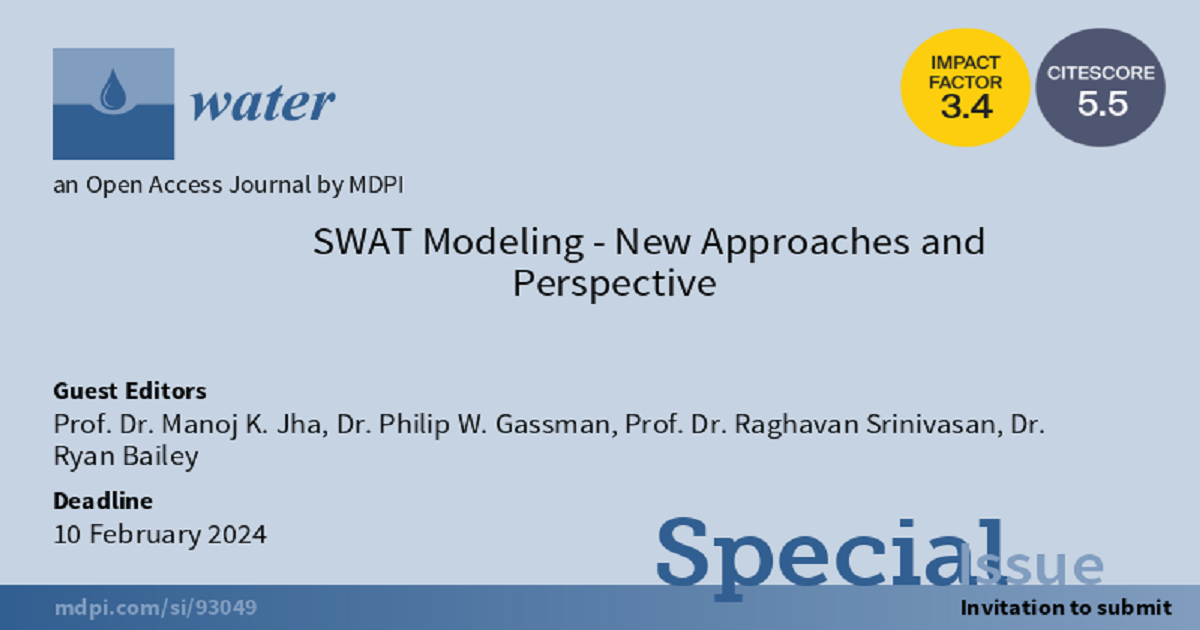SWAT Modeling - New Approaches and Perspective
A special issue of Water (ISSN 2073-4441). This special issue belongs to the section "Hydrology".
Deadline for manuscript submissions: closed (10 February 2024) | Viewed by 19658

Special Issue Editors
Interests: water cycle; field and watershed modeling; water resource engineering and management; climate change and land-use change impacts on hydrology and water resources; evaluation of BMPs for sediment and nutrients; extreme hydrological events (floods and droughts); uncertainties in modeling and assessment
Special Issues, Collections and Topics in MDPI journals
Interests: SWAT ecohydrological modeling; impacts of BMPs; cropping systems; land use and climate on hydrology and water quality; tile drain effects on flow and pollutant transport; integrated modeling systems
Interests: computational modeling of hydrology; water quality and spatial sciences problems; development and worldwide application of the SWAT model
Special Issues, Collections and Topics in MDPI journals
Interests: groundwater hydrology; coupled surface/subsurface hydrologic modeling; contaminant transport in watershed systems; SWAT; SWAT+; SWAT-MODFLOW
Special Issues, Collections and Topics in MDPI journals
Special Issue Information
Dear Colleagues,
The soil and water assessment tool (SWAT) model is an eco-hydrological modeling simulation tool that has been applied in various hydrologic and environmental conditions across the globe. The SWAT model is a physically based, semi-distributed, and continuous-time hydrological model. The model was developed to assess and predict the long-term multiscale impacts of land use/cover changes, land management practices, climate variability and change on watershed hydrology, soil dynamics, and fate and transport of non-point source pollutants at the watershed or river basin-scales. Major improvements have been incorporated into the current SWAT+ codes, including more detailed spatial representation, routing of flow and pollutants between HRUs and/or landscape units, and greatly simplified input file structure.
This Special Issue aims to attract high-quality research and review papers related to new and innovative approaches in the development and application of SWAT and SWAT+ models. Potential topics include (but are not limited to) the following: new enhancements and tools for SWAT+; SWAT+ linkages with other models; large-scale applications; groundwater and surface water interactions; carbon and nitrogen cycles; GHG emissions, fate, and transport of pollutants; wetland, potholes, and tile drains; improved accounting of LAI depiction and plant growth; urban landscapes; and others.
Prof. Dr. Manoj K. Jha
Dr. Philip W. Gassman
Prof. Dr. Raghavan Srinivasan
Prof. Dr. Ryan Bailey
Guest Editors
Manuscript Submission Information
Manuscripts should be submitted online at www.mdpi.com by registering and logging in to this website. Once you are registered, click here to go to the submission form. Manuscripts can be submitted until the deadline. All submissions that pass pre-check are peer-reviewed. Accepted papers will be published continuously in the journal (as soon as accepted) and will be listed together on the special issue website. Research articles, review articles as well as short communications are invited. For planned papers, a title and short abstract (about 100 words) can be sent to the Editorial Office for announcement on this website.
Submitted manuscripts should not have been published previously, nor be under consideration for publication elsewhere (except conference proceedings papers). All manuscripts are thoroughly refereed through a single-blind peer-review process. A guide for authors and other relevant information for submission of manuscripts is available on the Instructions for Authors page. Water is an international peer-reviewed open access semimonthly journal published by MDPI.
Please visit the Instructions for Authors page before submitting a manuscript. The Article Processing Charge (APC) for publication in this open access journal is 2600 CHF (Swiss Francs). Submitted papers should be well formatted and use good English. Authors may use MDPI's English editing service prior to publication or during author revisions.
Keywords
- SWAT
- SWAT+
- watershed modeling
- new approaches in SWAT
- tools for SWAT
- modeling advances
- linkages with other models/tools








